100 New Routes Opened, but Untapped Potential Abounds in Saudi Arabia
This article originally appeared on Climbing
Whoops and hollers echo off the narrow canyon walls. Faces turn upwards scanning sandstone walls, which stretch hundreds of feet above. The space is a cool, shaded canyon, no wider than 30 feet across. Climbers, a mix of local Saudi Arabians and those who had traveled far, stand grouped together in total awe.
"History is going to be made today," says Rana Ahmed, a local climber.
Climbing in Saudi Arabia is a new concept. The sport was born locally from young Saudis who studied or worked abroad and then returned home with a newfound appreciation for the rocky terrain. Within the last three years, the Saudi Climbing Federation was created with the purpose of developing climbing areas, teaching best practices, and organizing competitions. Several crags have since been developed throughout the country, with the strongest community around the country’s capital, Riyadh.
As part of a larger project to develop the tourism industry in Saudi, a group of five international climbers were commissioned to bolt over 100 single pitch routes in the middle of the desert near the exciting new development of NEOM. In November 2021, I was privileged enough to attend Saudi Arabia's first climbing festival, Rise 100.
***
The day we arrive, we ditch half the air pressure from the tires and turn off the end of the road, heading out into what feels like a drained underwater sea world. The sculptures that surround us are mind bending. The deeper we travel into this world, the more wonders are revealed. The western edge of Saudi Arabia is brimming with sandstone, rising as sheer, crimson monoliths above the desert floor. From above, the structure of the desert is like a tree's root system, with sandy valleys veining out in all directions, carving the most improbable towers.
The same geology, impartial to borders, continues up into Wadi Rum, a well-known climbing destination in Jordan. The Saudi sector, however, has remained relatively undiscovered. Such untapped potential is an exciting prospect for local and international climbers alike.
Herds of camels that belong to local Bedouin families roam freely. It’s amazing to see how the Bedouin families live as they have for thousands of years, colonists of the desert. When looking more closely it's not unusual to find beautiful petroglyphs carved into the rock, or to find untouched tombs that have stood for millennia. But the number of people who choose to live in the desert is now slim pickings and, just like in western cultures, Saudis are turning to their landscapes for recreation.
Our driver delivers us to a camp, which is breathtaking. White marquees outline the camp and at the heart, a fire pit, rugs and a stage are set within a natural rock amphitheater, jutting some 500 feet above us. We're invited to pitch our tents with the rest of the climbers, adding to a colorful patchwork of weekend homes. It feels like a British music festival--happy faces and everyone looking forward to the weekend.
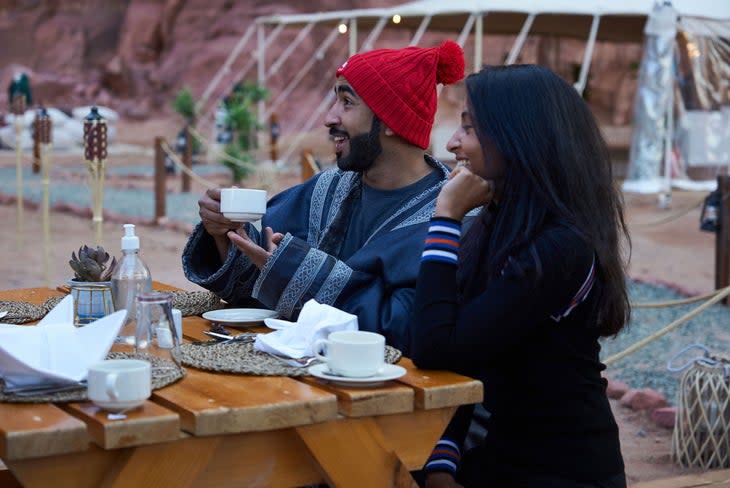
The Grand Unveiling
On the first day of the Rise 100 competition, climbers from all over the world gather for a breakfast buffet that is fit for kings. The conversation over breakfast flows easily and before long, I start to get a sense of the kindness that exists within the Saudi climbing community. The nervous expectations I had in anticipation of coming to this country, a country that's often portrayed so differently to where I come from, started toppling like dominos.
"It's really a very special weekend, because the climbing area here in NEOM has only just been bolted over the previous two months" says Nasser Alzuhufi, a keen climber and the Climbing Affairs Manager of the federation. "It's really great to see the Saudi climbing community travel here as well as some international climbers like yourself ready to enjoy the grand unveiling!"
The event is called to start. With strong Arabic coffees in hand, we move to the central stage, where an entertaining briefing is given by explorer George Bullard, the event's M.C. He shares the ethos behind the festival and explains the competition format. Teams of two or three must complete as many climbs as possible, over a two-day period, with a mandatory stop each day at 4 p.m.
Before everyone is released, each team is presented with a beautiful new guidebook, which initiates a flurry of excited page turning. The three climbing areas are spread out across the desert and teams need a reliable four-wheel-drive vehicle to access them.
Leaving one of the many meandering desert paths, we aim our land cruiser for a split in the dunes. Soon the cliff walls part and we enter the beginning of a stunning canyon. The cool sand splashes over our trainers as we wander deeper. The newly glued bolts glisten above.
We wander in awe down the narrow neck of the canyon until it opens like the body of a bottle. Boulders speckled with green foliage dot the sand. "It’s heaven on earth," I hear one climber say--an apt description.
Read Macadam, the head developer, looks on, as content as Santa Claus handing out presents on Christmas morning. Huge grins reflect in his eyes from the climbers. The psyche of the Saudi climbing community surprises me somehow. I had expected more reserve, but the scene is far from that. It’s warm and welcoming.
"Well, climbing just kind of started in Saudi," Rana Ahmed tells me. She's been climbing for three years. "The community is growing and the more there is development of different areas like this, then the more accessible it becomes to people. Right now it really feels like a small family, you support each other, share experiences and information so people don't have to work out everything from scratch. There is a really strong bond in the community and, because there is not so many of us, most people know each other"
The day passes in a blur of climbing. The rock quality in general is perfect, with thickly featured walls. A lack of good cracks means that traditional gear placements are rare. It isn't like climbing splitter cracks in Indian Creek, but it's got its own style, made up of rounded holds and funky chicken heads. Sometimes things get pretty blank and the game changes to playing with the friction, of which there is plenty. The bulk of climbs in this area are 80-feet pitches, from 5.10 to 5.12b, with the steepest walls found at the neck of the bottle.
That night we indulge in a buffet dinner that spans almost as far as the sky of stars above. It’s so fun to enjoy different cultures’ food. The lit amphitheater of rock that surrounds the camp makes for the perfect ambience. Everyone is getting to know each other, all enjoying that pleasant, tired feeling that comes from being outdoors all day and trying hard. The evening is filled with wide ranging talk of the area's history, which dates back to humans living there 63,000 years ago. Hopes for the area's future and tall tales of outrageous adventures provide plenty of inspiration. It’s clear by the end of the night that NEOM has been looking carefully at how they want to develop these beautiful places and that they really are planning to do it with respect and sustainability at its heart.
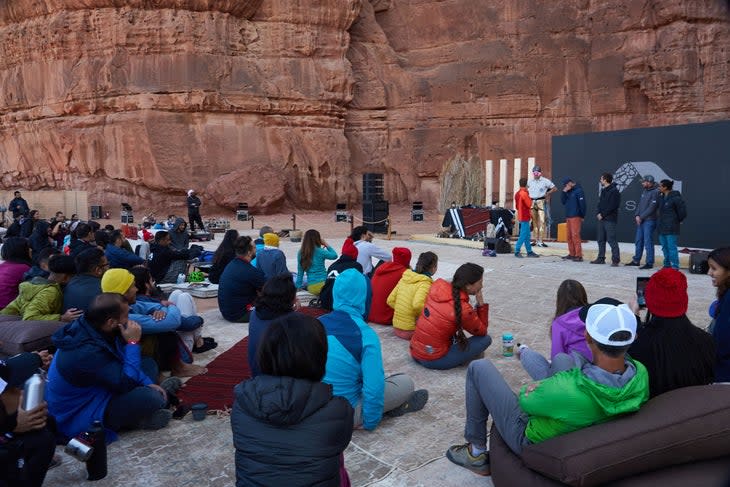
The Pillar
The next day, teams visit the two other climbing areas that Read and his team have bolted. I instantly see the major attraction of Area B. A huge pillar of rock that looks like a toppled book, lies at a jaunty angle, its spine making for a 130-foot overhung jungle gym--the obvious king line. As I look past the pillar, I see there is a whole variety of climbs. The darker varnish of the Wingate slabs provide a different kind of style, whilst the shorter but vertical walls of another area offer fun moves through cheese-hole jugs.
I can't wait to shoot photos on the main line of the crag. Sitting under this airy pillar, I spoke with professional climbers Emily Harrington and her partner Adrian Ballinger. We spoke about what it’s like to visit Saudi Arabia after visiting so many climbing destinations.
"We have sandstone towers in Utah," she says, "but it just feels bigger here. It feels more vast. You look in every direction and it feels like it just goes forever." She's not exaggerating--as far as we can see there's an endless expanse of rock. "It's been super cool to see that there is a very strong, stoked contingent of female climbers here and it's really exceeded all my expectations. It’s wonderful. I can't wait to take this all home with me and tell people that they should visit."
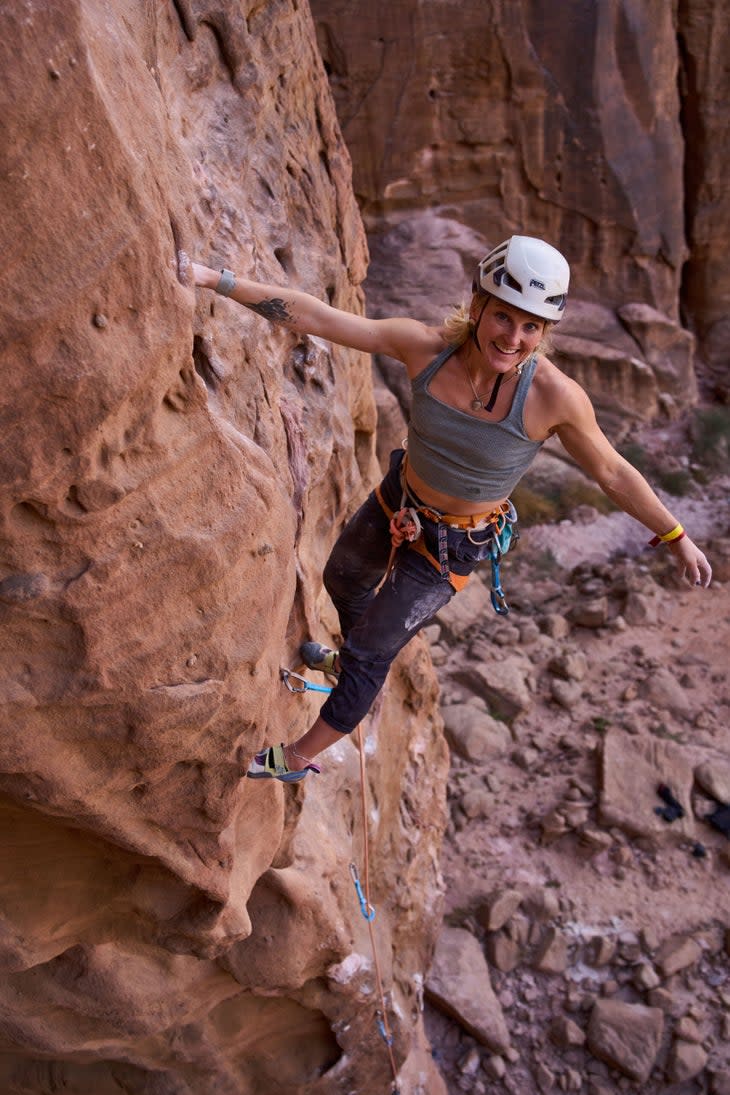
In the afternoon I enjoy hanging out at Area C. Here, a gigantic lump, somewhat reminiscent of Uluru (Ayers Rock), sits in the middle of the valley, mighty and gargantuan. On one side is a friendly slab, creating an ideal introduction crag to the area. On the shadier aspect is a steep, textured overhang, which promises athletic moves to the chains. Here, I meet Yasmin Gahtani, a mother of young twins and the managing director of the Saudi climbing and hiking federation.
"Saudi has so much potential. There's a lot of different types of rock, so it's nice to climb in different areas here," she tells me while tying in. "The federation was established in 2018, so we’re still young and growing slowly, but the community is developing with it, and that's amazing." Reflecting on the event, she adds, "The competition is going really well, a lot of people are really excited about it. They love the challenge and the excitement, and at the same time, are having a lot of fun. All these routes are new to everyone, no one has climbed them yet, so everyone is really happy, and I'm happy to see that."
The question I really want to ask is, "What's it like to be a female Saudi climber?" I feel somewhat shy and perhaps even ignorant. I feel the question had been in part answered by the crowd itself--there were many smiling female faces--but I want to know more. "For women, a lot of things have changed here," she tells me. "But when it comes to climbing, we've always been climbing with the guys. So, we've never felt any different to them. The guys have always been supportive," she says. "My belay partner is a lot taller than me, and there's some routes that he can do and I can't and vice versa, but it is what it is, and we just support each other." She starts lowering her partner and whizzes towards the wall with a happy laugh. "See, he's a bit heavier, but it doesn't matter." Laters, she says:
"My main goal for the federation is to have more people climbing in Saudi, regardless if they are from Saudi or not. It’s great to see people just come to visit Saudi. I have two twins and I'm so happy to be the mother of two climbers, who I hope one day will compete. They've been climbing since they were 4. They are now 12 and they love climbing."
Before I arrived in Saudi Arabia, I had formed expectations about the place from its often negative portrayal in the Western media. Preconceptions are easy to have. However, as I left Saudi, my resounding feeling was how at odds my experiences were with the picture that is often painted in the West about the country. I witnessed a mutual love for beautiful places and a great sport, no matter where the person was from, what their experience in the sport was, or what they believed outside of the sport. Respect was given in abundance.
100 routes is just a tiny sample of what is waiting to be unwrapped in this vast desert area. It’s going to be wonderful to see how the Saudi climbing community thoughtfully develops this wild space.
Gallery
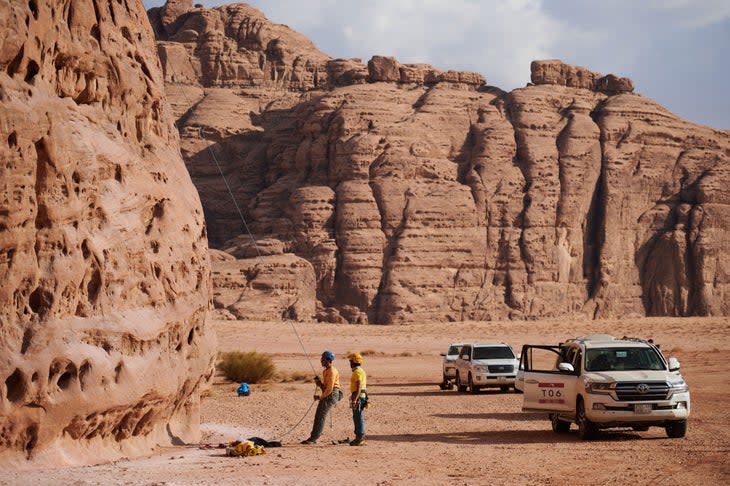
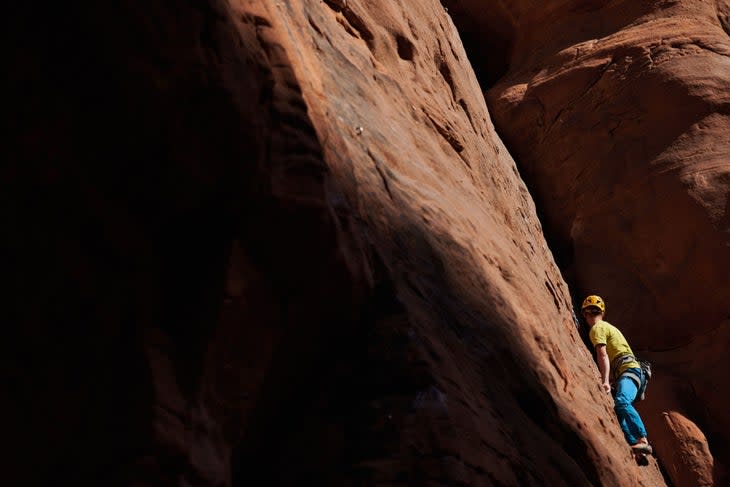
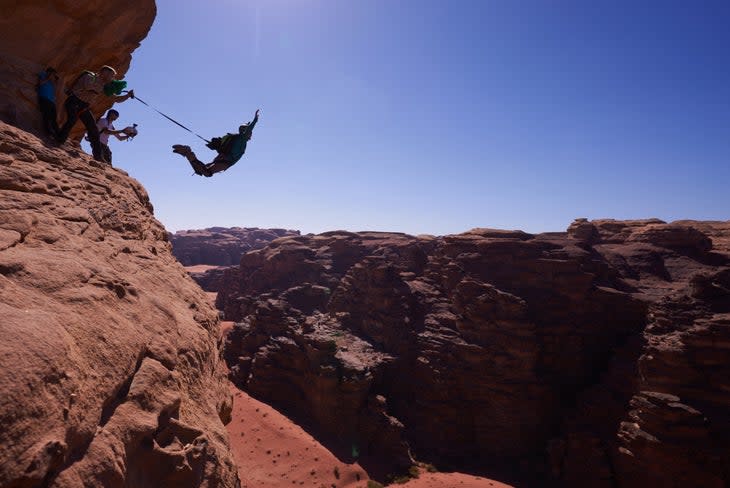
For exclusive access to all of our fitness, gear, adventure, and travel stories, plus discounts on trips, events, and gear, sign up for Outside+ today.

